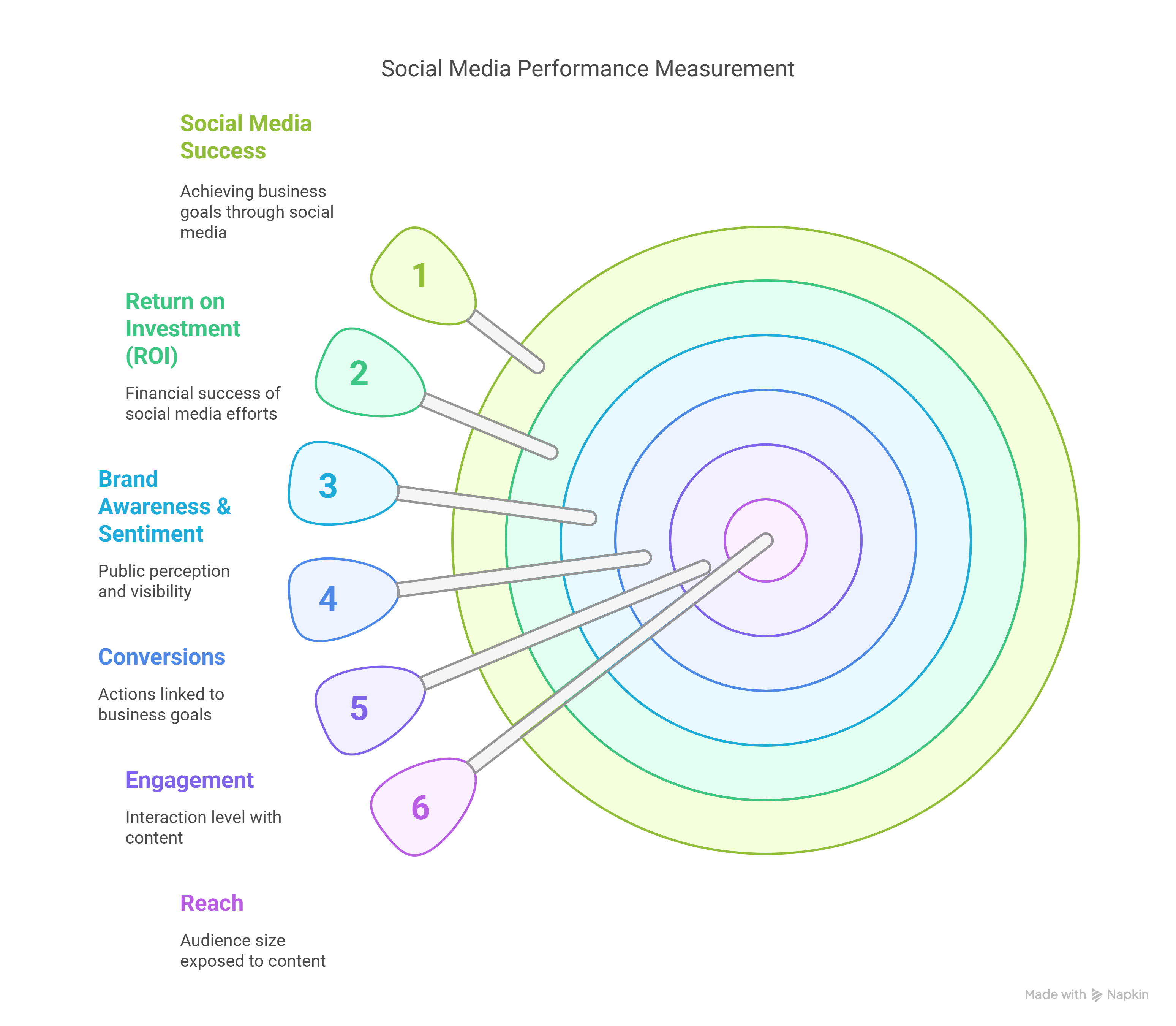Measuring Social Media Results
Why Measure?
- Understand what content resonates with your audience.
- See if you're achieving your goals (from your strategy).
- Justify time and budget spent on social media (demonstrate ROI).
- Identify areas for improvement and optimize your efforts.
Key Performance Indicator (KPI) Categories:
These are the main areas you'll track:
-
Reach: How many people are seeing your content?
- Explanation: Measures the size of the audience exposed to your posts. Important for brand awareness goals.
-
Metrics:
- Impressions: Total number of times your content was displayed.
- Reach: Number of unique people who saw your content.
- Audience Growth Rate: How quickly you're gaining followers.
- Example: The bookstore wants more local people to know they exist. They track Reach on their posts to see how many unique individuals in their area see their content each month.
-
Engagement: How are people interacting with your content?
- Explanation: Measures likes, comments, shares, clicks, etc. Shows if your content is interesting and sparks conversation. High engagement suggests content relevance.
-
Metrics:
- Likes/Reactions, Comments, Shares: Direct interactions.
- Clicks: Clicks on links, profiles, photos, etc.
- Engagement Rate: (Total Engagements / Reach or Impressions) * 100%. A key indicator of content quality relative to audience size.
- Example: The bookstore posts a question: "What's the best book you read last month?" They track the number of Comments and calculate the Engagement Rate to see how well the question resonated compared to other posts.
-
Conversions: Are people taking the desired actions?
- Explanation: Measures actions linked directly to business goals, like visiting your website, signing up, or buying something. Crucial for demonstrating direct impact.
-
Metrics:
- Website Traffic: Visitors coming from social media links.
- Leads Generated: Sign-ups for newsletters, webinars, or contact forms originating from social.
- Sales/Revenue: Purchases made after clicking a social media link (requires proper tracking setup).
- Conversion Rate: (Conversions / Clicks) * 100%.
- Example: The bookstore promotes an online author event with a sign-up link. They track how many Leads Generated (sign-ups) came specifically from their Instagram link sticker.
-
Brand Awareness & Sentiment: How is your brand perceived?
- Explanation: Measures how visible your brand is and the overall feeling (positive, negative, neutral) people express towards it online.
-
Metrics:
- Mentions: Times your brand name is mentioned (tagged or untagged).
- Share of Voice: Your brand's mentions compared to competitors.
- Sentiment Analysis: Analyzing mentions to gauge overall feeling.
- Example: The bookstore monitors social media for mentions of their name. They look at customer reviews posted on Facebook and Google (linked from social) to understand Sentiment.
-
Return on Investment (ROI): Are you making more money than you're spending?
- Explanation: The ultimate measure of financial success. It compares the revenue generated from social media activities against the costs (tools, ads, time). Requires careful tracking of sales tied to social efforts.
-
Metric:
(Revenue from Social - Social Media Costs) / Social Media Costs - Example: The bookstore spends $100 on Facebook ads promoting a sale.
They use tracking links and coupon codes to determine that those ads directly resulted in $500 in online sales. Their ROI is ($500 - $100) / $100 = 4 or 400%.
Data Sources:
- Platform Analytics: Facebook Insights, Instagram Insights, Twitter Analytics, etc. (Provide reach, engagement, follower data).
- Web Analytics: Google Analytics (Tracks website traffic, conversions from social sources).
- Social Media Management Tools: Hootsuite, Buffer, Sprout Social (Often aggregate data from multiple platforms).
- CRM Systems: Salesforce, HubSpot (Track leads and customer journeys initiated via social).
Reporting:
- Analyze Regularly: Review your key metrics weekly, monthly, or quarterly depending on your goals and campaign cycles.
- Look for Insights: Don't just report numbers; analyze why certain posts performed well or poorly.
- Optimize: Use the data to make informed decisions about future content, platform focus, and strategy adjustments.


No Comments